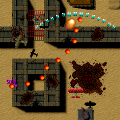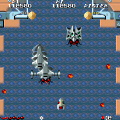Namco practically invented the vertical shooter as we know it with Xevious, released in 1983. They expanded on the formula with Dragon Spirit (1987) and Dragon Saber (1990), changing the well-worn sci-fi setting of Xevious into a high fantasy one, replacing spaceships with dragons. Sandwiched in the middle of those releases is Phelios, which seems outwardly similar to the two Dragon games, but changes the setting to one inspired by Greek mythology.
You control Apollo (or Apollon, in the Japanese version), riding on top of the mighty winged horse Pegasus. Your goal is to rescue his girlfriend, the goddess Artemis, from the evil titan Typhon. Anyone familiar with Greek mythology will find this to be a little bit wrong, considering Apollo was actually Artemis’ brother, not lover, but then again that whole canon is known for being somewhat sordid anyway. Boss enemies include Medusa, the Graenae (the three witches), the Siren, Antaeus, the Siren (who looks more like a harpy), Scylla and Cerberus.
Apollo is armed with a sword, which can fire charged blasts of energy. He can also take a number of hits (between one and five, depending on the settings of the arcade cabinet and the health power-ups obtained), though the large size of the sprite makes dodging fire more difficult than many other arcade shooters. Getting killed will take you back to an earlier checkpoint. The primary difference between Phelios and Namco’s other vertical shooters is that while there are ground-based enemies, there is no separate bomb button, so they can be destroyed with regular attacks.
Additional weapons include a rapid-fire Beam, the bouncing Across fire, and Homing attacks. The latter two work in conjunction with the standard weapon, rather than replacing it, so they continue to fire even when you’re charging up the main attack, which is quite handy. Collecting the letters PHELIOS will grant you the titular weapon, which is an exceedingly powerful charge attack, though it’s only available in the last level. Unfortunately you’re only granted a limited amount of time to use these special weapons before they disappear. You can also gain Options, little glowy orbs that shadow your movement and fire, exactly like Gradius. However, the number of Options also determines how much damage boss creatures can take, often strengthening them beyond what their form would be like if you went into battle unequipped.
The fanciest gimmick is the prevalent use of scaling and rotation effects, thanks to the Namco System 2 hardware, which also powered Valkyrie no Densetsu and Assault to similar ends. Right at the beginning of the first stage, as soon as Apollo launches his assault, he divebombs from a cliff down to the earth below, which twists and turns sporadically. At the end of this segment, Apollo rises into the sky to scale a cliff, before diving back down to the surface, avoiding fire from a turret consisting of eyeball-firing skulls, before entering the shrine to face the first boss.
Not only is this a remarkably impressive effect, but it gives Phelios a remarkably cinematic feel. Every time Apollo launches forward in another direction, a little text scroll narrates the action, and the music changes to suit the pacing. It’s a rousing, dramatic score by Yoshinori Kawamoto that brilliantly accompanies the gameplay. But the downside to this dynamic soundtrack is that it’s not nearly as catchy as Dragon Spirit / Dragon Saber.
After defeating a boss, Apollo flies over a pool, which shows Artemis’ current state of distress. It mostly amounts to her being bounded up in skimpy, torn clothing while begging for Apollo to hurry up and save her, all while Typhon brazenly taunts them. It’s a device directly borrowed from the revised version of Namco’s own Rolling Thunder. Artemis also begs for your help at the continue countdown screen – manipulative, maybe, but probably effective.
While there are a few other shooters that share the ancient Greek setting – Konami’s Knightmare and Compile’s Sylphia being the most noteworthy – Phelios is easily the best looking of the lot, and the special effects elevate it above the level of many others of the era.
Phelios was ported to the Genesis, marking its first English release. (The arcade version was only released in Japan.) Strangely, all of the text is in English, even in the Japanese release. Most of the graphics have been entirely redrawn, and it looks a little darker, though still decent. There was absolutely no hope in replicating the scaling and rotation effects on the hardware, so the levels have been revamped to revise these sections.
Despite losing one of its main gimmicks, the game itself doesn’t really suffer all that much for it, besides losing the gee-whiz factor. In fact, in one instance the lack of scaling graphics actually works in its favor. In the arcade game, most of the boss sprites are scaled up from a lower resolution, making them look ugly and pixellated. They’re completely redone at the proper resolution in the Genesis port, so they look much better.
Other changes are minor. You can only carry two options rather than three. The status and weapon charge bar have been moved to the right side side of the screen, giving the playing field a more narrow viewpoint, even though the screen ratio isn’t the same as the arcade game. There’s some different music, so the score is a little less repetitive, if not as nice sounding. Additionally, the option menu includes small text screens that explain the story of each stage. In addition to the two difficulty modes that the arcade game offers (the easiest only lets you play four out of seven stages), there’s also an unlockable third difficulty level. You are granted three continues, but cheat codes can increase this to nine.
Though missing from most Namco retro game compilations, both the Genesis and arcade versions were released on the Wii Virtual Console in Japan.
Screenshot Comparisons





























